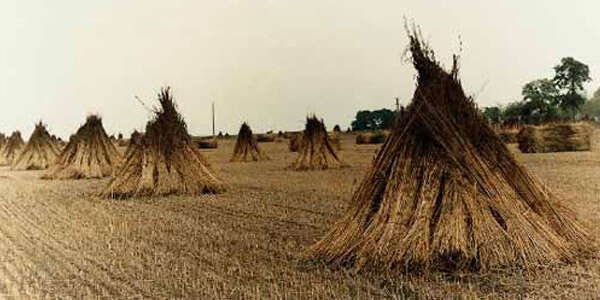11 Reasons Why Hemp Clothing Is Eco-Friendly
As an Amazon Associate, Ecotero earns from qualifying purchases.
Hemp clothing is often touted as one of the most eco-friendly clothing options for eco-conscious consumers today.
But what exactly makes hemp clothes better for the environment?
Is hemp clothing really as eco-friendly and sustainable as advertised?
Well, there are 11 good reasons why hemp clothing is considered to be better for the environment – some of which might even surprise you!
Let’s check them out.
And while you’re here, you can check out our buyer’s guide to the top hemp clothing brands.
1. Cultivation of hemp requires less resources
Right off the bat, one of the main reasons why hemp clothing is eco-friendly is because hemp cultivation requires less natural resources.

This is especially true when you compare hemp cultivation to that of cotton, the most popular and commonly used clothing fabric.
Production and processing of cotton uses a large amount of water. (All data sources and references below)
Cotton is even considered by some experts to be the largest user of water among all agricultural commodities.
Meanwhile, hemp can grow and thrive with little-to-no irrigation, saving water in the process.
Cotton also requires approximately twice as much land per ton of finished textile compared to hemp.
Hence, choosing to plant hemp instead of cotton will open up more land space for other crops or trees.
2. Hemp can help clean contaminated soil
Yes, you read it right.
Besides consuming less natural resources, planting hemp can also be used for phytoremediation – a practice of using plants to decontaminate soil.
This is because unlike other crops, hemp can grow perfectly healthy on contaminated soil while absorbing toxins and other contaminants.
Hence, hemp not only allows farmers to utilize infertile lands, it also removes harmful contaminants from the soil making it viable for other crops in the future.
And guess what?
Besides removing toxins and chemicals, hemp also absorbs heavy metals from the soil that can be toxic to humans when absorbed in high doses.
Because of this, hemp has been used to help decontaminate the soil in Chernobyl and have yielded some positive results!
3. Hemp can survive without pesticides
The growing of hemp requires lower use of pesticides, herbicides, and fungicides.
And as you may already know, pesticides can potentially harm nearby crops, bees, or contaminate the environment.
Hemp is naturally resistant to pests, so they’re less likely to be infested by moths or other insects without applying pesticides.
This is all thanks to hemp’s inherent anti-bacterial properties (similar to Bamboo Kun).
Meanwhile, conventional cultivation practices for cotton involve application of substantial pesticides threatening the quality of soil and water and the biodiversity near the cotton plantation.
And did you know that cultivating cotton uses approximately 25% of the world’s insecticides and more than 10% of the pesticides?
For instance, it is estimated that farmers, on average, use 5.3 oz of chemicals (including pesticides and fertilizers) to produce one pound of cotton fabric.
Furthermore, according to the USDA (United States Department of Agriculture), cotton is the third most pesticide-sprayed crop.
Besides environmental hazards, heavy use of pesticides also raises concern for the health of farm workers and nearby populations.
But to be fair, there are still some farmers who still use environmentally damaging fertilizers and chemicals when growing hemp.
To make sure that the hemp clothing you buy is free from harsh chemicals, make sure it is made from organic hemp.
It would also help if you can thoroughly study the hemp clothing you’re considering buying from.
4. Production of hemp fabric is less damaging to environment
The processing and manufacturing of hemp fabrics leaves a much lighter environmental footprint than other fabrics.
For starters, the processing of hemp fabrics produces fewer toxic substances that can cause environmental pollution near the textile mill.
Meanwhile, cotton production requires bleaching and is chemical intensive.
The same can be said for most bamboo fabrics.

And though bamboo fabric is more eco-friendly than cotton, hemp fabric beats both cotton and bamboo in terms of overall eco-friendliness.
- Read more about hemp vs bamboo fabric
Production of hemp fabric also uses less energy compared to other fabrics because it’s usually made from low-energy processes like retting, spinning and weaving.

5. Hemp fabric is an ethical and sustainable fabric
Hemp fabric is made from natural fibers of a sustainable and renewable crop.
Meanwhile, most synthetic fabrics like polyester are made from petroleum.
We don’t have to tell you that the majority of petroleum products are made from coal, natural gas, and other non-renewable Earth resources.
But what about wool? Aren’t they made from renewable resources?
Unfortunately, wool is considered by many conscious consumers to be obtained through the exploitation of animals.
Producers of wool purposely breed sheeps to have wrinkled skin to produce more wool.
However, the extra skin and wool causes sheeps to sweat more and increases the risk of the animals getting illnesses and infections.
And its sad to note that in some areas, production of cotton still involves forced labor and slavery.
In Uzbekistan, for example, people are forced to work on cotton fields to pick “white gold.”
6. Hemp fabric is durable and long lasting
Did you know why bibles are often made with hemp paper?
The first Levi’s jeans were also made out of hemp fabric.

This is because hemp fiber is a very durable natural fiber.
When made into fabric, hemp retains its durability and is less prone to wearing out or breaking down when exposed to the elements.
A more durable clothing means it will last longer despite repeated wash and wear, saving raw materials, energy, resources, and money.
More importantly, because durable clothing lasts longer, you will create less trash from old clothes and contribute less trash to landfills.
7. Clothes made with hemp fabric is breathable
Okay, you might be thinking:
“What does a fabric’s breathability have to do with it being eco-friendly?”
Hemp fabric being breathable makes for a better material to wear during summer and for people in hot climates.
Wearing breathable fabric on hot days will reduce your dependence on electric fans, air conditioning, and other electric cooling devices.
This in turn helps minimize electric consumption which is eco-friendly, especially in areas where the electric grid is produced by burning fossil fuels.
8. Hemp clothing is easy to clean and maintain
Who would like to waste water and electricity washing clothes?
Fortunately, like most fabrics, hemp clothing can be dry cleaned or washed on the delicate cycle with cold water.
This means you won’t need to use extra electricity to warm your machine water.
Furthermore, you also won’t need any special fabric conditioner or detergent to clean hemp clothing as any eco-friendly laundry detergent can do the job for you.
9. Fabrics made of hemp reduce the clothing industry’s carbon footprint
As you may already know, the clothing and fashion industry is highly dependent on cotton for their products.
To give you some numbers:
About 60% of women’s clothing items contain cotton fiber.
Meanwhile, approximately 75% of the world’s clothing products contain at least some amount of cotton in them.
It’s not hard to see that in sheer numbers, cotton is the most widely used textile fabric in the world.
And at the moment, China is the leading producer and supplier of cotton.

The use of hemp fabric for clothing reduces our dependence on cotton imports from China, which in turn reduces the carbon footprint from shipping cotton.
10. Hemp can grow in different climates
Hemp plants can grow in many different climates making them a viable crop to grow in many areas of the world.
With the growth of the hemp clothing industry, many farmers will have a chance to generate additional revenue from cultivating hemp.
This also means that people who have no means of living can now consider growing hemp as there is already a constant demand for the material.
The same people who might have resorted to unethical means of livelihood like illegal logging and dynamite fishing to make both ends meet.
11. Hemp fabric is biodegradable
And the final reason why many people think hemp clothing is eco-friendly?
Clothing made with natural hemp fiber is biodegradable.
So they won’t stay in landfills for a long period of time, unlike synthetic fabrics.
Hemp clothing FAQ section
Is hemp clothing sustainable?
As you just read above, hemp clothing is sustainable given that:
- It is made from a sustainable crop.
- Hemp can grow in different climates and soil conditions.
- Growing hemp requires less water and land.
Why is hemp clothing good for the environment?
Hemp clothing is good for the environment (or eco-friendly) given that:
- Hemp clothing is sustainable.
- Growing hemp can help clean and decontaminate soil.
- Hemp can be grown without pesticides that can pollute the environment.
- Clothing made of hemp is durable and long-lasting.
- Hemp clothes are easy to wash and maintain.
- Textiles made of hemp help reduce the carbon footprint of the clothing industry.
- Hemp clothing is biodegradable.
Are hemp clothes breathable?
100% hemp clothing are very breathable.
However, they can feel a little bit coarser compared with other fabrics we are used to wearing, like cotton.
The good new is: Hemp fabric actually softens with every wash so the more you wear them, the softer they get.
Also, there are many hemp clothing options that are blended with other fabrics – the most popular is the hemp and organic cotton blend.
Meanwhile, hemp fabrics are lighter than most other natural fibers, which is why they’re often used for activewear and athletic wear.
Does hemp clothing last longer than cotton?
Although hemp fiber is naturally more durable than cotton, the longevity of your clothing depends on how you use and care for them.
But if taken care of properly, hemp clothing should last long.
Final thoughts on why hemp clothing is eco-friendly
At this point, we hope you now have a better understanding as to why hemp clothing is a highly sustainable and eco-friendly clothing option for anyone looking to green their wardrobe.
Anyways, we would like to hear your thoughts.
Which of the 11 factors above that makes hemp clothing eco-friendly is your favorite?
Do you know other reasons why hemp clothing is eco-friendly?
References
- Can Hemp Clean Up the Earth?
- Can hemp clothing save the planet?
- World Wildlife Organization – Cotton
- Phytoremediation
- Animal Ethics
- Is Hemp or Bamboo Clothing More Sustainable?
- Hemp: Facts on the Fiber
- How Cotton is Made – Made How
- Cotton and the Environment
- Pesticide Use in U.S. Agriculture
- Forced labour in Uzbekistan: In the land of cotton
- Is Hemp the New Vegan Wool?
- How Much of the World’s Clothing Is Made From Cotton?
- What is Cotton Fabric: Properties, How its Made and Where
